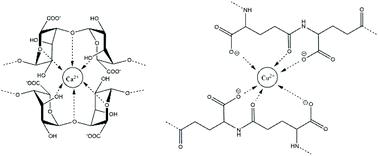当前位置:
X-MOL 学术
›
Biomater. Sci.
›
论文详情
Our official English website, www.x-mol.net, welcomes your
feedback! (Note: you will need to create a separate account there.)
Chelate chemistry governs ion-specific stiffening of Bacillus subtilis B-1 and Azotobacter vinelandii biofilms.
Biomaterials Science ( IF 5.8 ) Pub Date : 2020-01-28 , DOI: 10.1039/c9bm01763a Martin Kretschmer 1 , Oliver Lieleg
Biomaterials Science ( IF 5.8 ) Pub Date : 2020-01-28 , DOI: 10.1039/c9bm01763a Martin Kretschmer 1 , Oliver Lieleg
Affiliation

|
Unwanted formation of bacterial biofilms can cause problems in both the medical sector and industrial settings. However, removing them from surfaces remains an ongoing challenge since biofilm bacteria efficiently protect themselves from external influences such as mechanical shear forces by embedding themselves into a matrix of extracellular polymeric substances. Here, we discuss microscopic principles, which are responsible for alterations in the viscoelastic properties of biofilms upon contact with metal ions. We suggest that it is a combination of mainly two parameters, that decides if biofilm stiffening occurs or not: the ion size and the detailed configuration of polyanionic macromolecules from the biofilm matrix. Our results provide new insights in the molecular mechanisms that govern the mechanical properties of biofilms. Also, they indicate that hydrogels comprising purified biopolymers can serve as suitable model systems to reproduce certain aspects of biofilm mechanics - provided that the correct biopolymer is chosen.
中文翻译:

螯合物化学控制枯草芽孢杆菌B-1和藤蔓固氮菌生物膜的离子特异性硬化。
细菌生物膜的有害形成会在医学领域和工业环境中引起问题。然而,将它们从表面去除仍然是一项持续的挑战,因为生物膜细菌通过将自身嵌入到细胞外聚合物质的基质中,有效地保护自己免受外部影响,例如机械剪切力。在这里,我们讨论微观原理,这些原理负责与金属离子接触的生物膜粘弹性的改变。我们建议这主要是两个参数的组合,它决定是否发生生物膜硬化:离子尺寸和来自生物膜基质的聚阴离子大分子的详细构型。我们的结果为控制生物膜的机械性能的分子机制提供了新的见解。也,
更新日期:2020-01-28
中文翻译:

螯合物化学控制枯草芽孢杆菌B-1和藤蔓固氮菌生物膜的离子特异性硬化。
细菌生物膜的有害形成会在医学领域和工业环境中引起问题。然而,将它们从表面去除仍然是一项持续的挑战,因为生物膜细菌通过将自身嵌入到细胞外聚合物质的基质中,有效地保护自己免受外部影响,例如机械剪切力。在这里,我们讨论微观原理,这些原理负责与金属离子接触的生物膜粘弹性的改变。我们建议这主要是两个参数的组合,它决定是否发生生物膜硬化:离子尺寸和来自生物膜基质的聚阴离子大分子的详细构型。我们的结果为控制生物膜的机械性能的分子机制提供了新的见解。也,









































 京公网安备 11010802027423号
京公网安备 11010802027423号